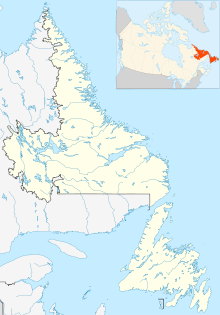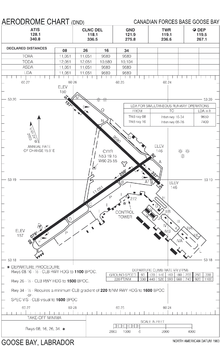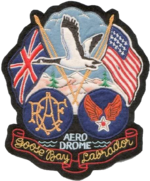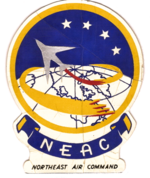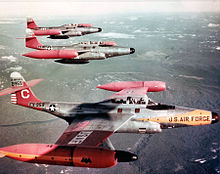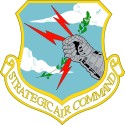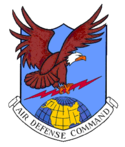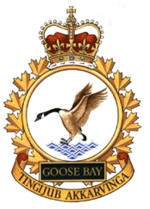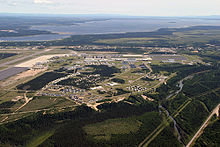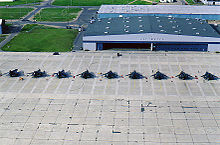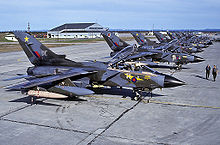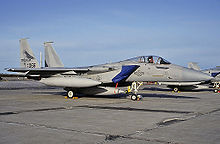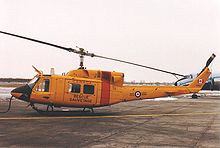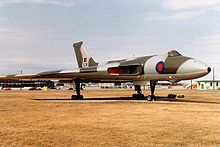- CFB Goose Bay
-
CFB Goose Bay
Goose Bay Airport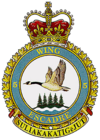
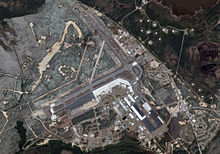
IATA: YYR – ICAO: CYYR
– WMO: 71816Summary Airport type Military/Public Owner Government of Canada Operator DND
Goose Bay Airport CorporationLocation Goose Bay, Labrador Elevation AMSL 160 ft / 49 m Coordinates 53°19′09″N 060°25′33″W / 53.31917°N 60.42583°WCoordinates: 53°19′09″N 060°25′33″W / 53.31917°N 60.42583°W Website Map Location in Newfoundland and Labrador Runways Direction Length Surface ft m 08/26 11,051 3,368 Concrete with asphalt overlay 16/34 9,580 2,920 Concrete with asphalt overlay Statistics (2010) Aircraft movements 28,871 Source: Canada Flight Supplement[1]
Environment Canada[2]
Movements from Statistics Canada.[3]Canadian Forces Base Goose Bay (IATA: YYR, ICAO: CYYR) (also CFB Goose Bay), is a Canadian Forces Base located in the town of Happy Valley-Goose Bay, Newfoundland and Labrador.
CFB Goose Bay is presently operated as an air force base by the Royal Canadian Air Force and is the site of NATO tactical flight training in Canada.
The base was initially a Royal Canadian Air Force station[4] and later a United States Air Force base known as Goose AFB, housing units of the Strategic Air Command[5] and Aerospace Defense Command. It was later home to permanent detachments of the Royal Air Force, the Luftwaffe, the Aeronautica Militare, and the Royal Netherlands Air Force, in addition to temporary deployments from several other NATO countries. The base is the home of 444 Combat Support Squadron and also serves as a forward operating base for NORAD CF-18 Hornet interceptors.
CFB Goose Bay's airfield is also used by civilian aircraft, with civilian operations at the base referring to the facility as Goose Bay Airport. The airport is classified as an airport of entry by NAV CANADA and is staffed by the Canada Border Services Agency. CBSA officers at this airport currently can handle general aviation aircraft only, with no more than 15 passengers.[1]
Contents
Second World War
During World War II Newfoundland was a dominion in the Commonwealth of Nations. Fearing that a German invasion of Newfoundland could be used as a prelude to an attack on Canada, in 1940 Canadian Prime Minister William Lyon Mackenzie King and Newfoundland Governor Sir Humphrey T. Walwyn entered into negotiations regarding the strengthening of defensive positions along the Newfoundland coast.[citation needed] Notwithstanding that Newfoundland was a separate political entity, Canada built several strategic bases in Newfoundland and Labrador, including Goose Bay, to act as staging points in the eastern air route across the Atlantic via Greenland, Iceland, and the British Isles.
In the summer of 1941, an RCAF survey team determined a suitable location for an air base on a large low-lying plateau above the flood plain where the Churchill River emptied into Lake Melville. The westernmost portion of Lake Melville is Goose Bay, at the head of which is the harbour of Terrington Basin. These navigable waters, connected to the Atlantic Ocean through Groswater Bay, the outer portion of Hamilton Inlet, provided marine access and good anchorage for cargo ships which would service the base.
Construction soon followed the initial surveys and three (3) 7,000 foot runways were opened on 16 November 1941. The first military aircraft landed on 9 December. At this time, over 3,000 RCAF personnel were assigned to RCAF Station Goose Bay. Following the runway construction of 1941, workers continued to build other facilities on the base.
The Permanent Joint Board on Defence allowed the United States Army Air Forces (USAAF) to build its own facilities on the south side of the base. The United States facilities at Goose Bay were placed under the United States Army Newfoundland Base Command (NBC), which was assigned to the Northeastern (later Eastern) Defense Command (NBC). NBC's mission was to provide ground, antiaircraft, and harbor defense of the U.S. bases in Newfoundland, to work with Canada in defending Newfoundland, and to cooperate with United States and allied naval forces in Newfoundland defense.
By 1942 there were 1,700 USAAF personnel and 700 civilians posted to the base, making the area the largest population concentration in Labrador at the time. In 1943, RCAF Station Goose Bay was the busiest airport in the world and the neighbouring town of Happy Valley was created to house construction workers and civilian employees. In addition, USAAF aircraft from Antisubmarine Command used Goose Bay for patrols over Baffin Bay and the Greenland Coast, and Air Transport Command used the airfield as a staging and refueling base for several North Atlantic Transport routes from the United States to Iceland and on to Prestwick, Scotland. Numerous Eighth Air Force B-17 Flying Fortress and B-24 Liberators transited the airfield in their deployment to the European Theater of Oprations.
During the Second World War and the Cold War, the Royal Air Force used the RCAF facilities on the north side and was referred to as RAFU Goose Bay.
Following the war, the RCAF and USAAF maintained a presence at the base. On 31 March 1949 Newfoundland became Canada's tenth province when it entered Confederation.
United States Air Force use
Northeast Air Command
The USAAF was inactivated in September 1947 becoming the United States Air Force (USAF). The USAF retained usage of its facilities at the base, renaming its specific area Goose Air Force Base (AFB). Initially, the United States facilities at Goose Bay remained under the jurisdiction of the wartime Newfoundland Base Command. The NBC was inactivated by the Army on 1 October 1950, and jurisdiction of the United States facilities was transferred to the new USAF Northeast Air Command (NEAC). NEAC activated the 6606th Air Base Wing at Goose AFB initially for operation and control of the base support facilities and organizations.
The USAF Air Defense Command detached the 59th Fighter-Interceptor Squadron to Goose AFB on 28 October 1952, placing it under NEAC's 64th Air Division, headquartered at Pepperrell AFB. The 59th FIS operated F-89 Scorpion jet interceptors from the airfield, assisting in the air defense of the region.
The 6606th ABW also supported several tenant organisations on the base from Military Air Transport Service (MATS). The 1708th Ferrying Group transported Military Assistance Program aircraft from the United States to friendly governments in Europe and the Middle East. The MATS 8th Weather Squadron provided information both to USAF as well as RCAF and civilian weather organizations.
NEAC also activated the 6615th Air Transport Group (Medium) at Goose, which operated C-119 Flying Boxcar and C-54 Skymaster transports. In addition, it supported the 22d Helicopter Squadron operating YH-21 Shawnee helicopters, and SA-16 Albatross Amphibians used by the MATS 6th Air Rescue Group, Air Rescue Service. These aircraft operated over a wide area from Newfoundland, Labrador, Baffin Island various sites in Greenland supporting NEAC radar and early warning installations.
Goose AFB also supported numerous temporary deployments of Strategic Air Command (SAC) bombardment units from Second and Eighth Air Forces, using the base as a staging area for overseas deployments as well as a refueling stop. On 10 November 1950, a USAF B-50 bomber flying between Goose Bay and Davis-Monthan AFB, Arizona was forced to jettison and detonate three unarmed nuclear bombs over the St. Lawrence River near Saint André de Kamouraska, Quebec. As the plutonium cores of the bombs had been removed and stored at Goose Bay, the onboard bombs contained only the high explosive implosion assemblies, and were thus considered "unarmed". Encountering engine trouble, and with contemporary doctrine requiring that aircraft be lightened by dropping ordnance, the flight crew released the bombs. The weapons detonated at 2,500 feet (760 m) over the river — apparently causing no damage. The episode was not disclosed by the Canadian government until 2000.[1]
In 1953, the USAF signed a 20-year lease agreement with Canada for its continued use of the air base. Goose Bay's strategic location as one of the closest North American air bases (by flying time) to the Soviet Union ensured it a prominent role.
Strategic Air Command
Northeast Air Command was inactivated on 1 April 1957 and Strategic Air Command received jurisdiction of the USAF facilities. SAC activated the provisional 4082d Strategic Wing as its command and control facility at the base, being under the SAC Eighth Air Force, 45th Air Division. The 814th Combat Support Group took control of the base support organizations.
Goose Bay soon began to see B-47 Stratojet bombers and KC-97 aerial refuelling tankers, followed by KC-135 Stratotankers in 1960, using the base as a refueling facility and stopover during REFLEX deployments to SAC bases in the United Kingdom and Morocco.
The primary mission of the 4082d SW, however was to be a dispersal organization for SAC B-52 Stratofortress intercontinental bombers. The wing was not assigned B-52s on a permanent basis, it did however, support deployed aircraft from other SAC wings, along with KC-135 Stratotankers from 1957 until 1972. Goose Bay also took over many of the functions provided by the former Ernest Harmon AFB in Stephenville which closed in 1966. Throughout the 1950s and 1960s, Goose Bay was home to over 12,000 USAF personnel and their families.
The 4082d Strategic Wing was redesignated the 95th Strategic Wing in August 1966 as part of a program to allow SAC to retain the lineage of its provisional 4082d SW and to perpetuate the lineage World War II bombardment units with illustrious combat records.
During this time, there was a small RCAF presence on the north side of the base, however pending budget cuts in the late 1960s prior to unification saw the RCAF transfer its responsibilities for operation of the base to the Department of Transport in 1967.
Air Defense Command
While SAC received jurisdiction of the United States facilities at Goose AFB with the inactivation of NEAC, Air Defense Command (ADC) took over the USAF atmospheric defense forces (including the NEAC 64th Air Division). The 4732d Air Defense Group was activated as a tenant unit at Goose AFB on 1 April 1957 to provide command and control of ADC units assigned to the base.
The 59th FIS was upgraded to the F-102A Delta Dagger in 1960. It continued defensive patrols over the region until it was inactivated on 31 December 1969.
The 641st Aircraft Control and Warning Squadron established a radar station 53°17′45″N 060°32′24″W / 53.29583°N 60.54°W about 4 miles (6.4 km) west of the base in November 1957. The USAF designated the site as Melville Air Station and designated the site as "N-24", however it was dependent upon and was logistically supported by the 4732d ABG at Goose AFB. Radars operated by the 641st AC&WS consisted of CPS-5, CPS-6B, FPS-502, FPS-20A, FPS-87A; MPN-4, TPS-502, FPS-6A, FPS-6B sets. In 1963, with the advent of SAGE, Melville AS was re-designated as "C-24".
On 1 July 1963 the 4732d ADG was re-designated as the Goose Air Defense Sector with the establishment of the Semi Automatic Ground Environment (SAGE) Direction Center (DC-31). DC-31 was constructed near CFB North Bay, Ontario, 46°20′15″N 079°24′42″W / 46.3375°N 79.41167°W 971.1 miles (1,562.8 km) to the southwest. In 1966, control of DC-31 was reassigned to the 26th Air Division at Hancock Field, New York and the Goose ADS was inactivated. Subsequently, ADC activated the 37th Air Division at Goose AFB on 1 April 1966 to command its assets in Northeast North America, including the 59th FIS. It also received from the inactivating Military Air Transport Service responsibility for Air Forces Iceland and assigned it to the new 37th AD at Goose AFB.
On 16 January 1968 Air Defense Command was re-designated Aerospace Defense Command (ADCOM) as part of a restructuring of USAF air defense forces. ADCOM began inactivation of its assets at Goose AFB due of the need to eliminate intermediate levels of command in ADCOM driven by budget reductions and a perceived lessening of the need for continental air defense against attacking Soviet aircraft. The 59th FIS was inactivated and control of Air Forces Iceland was turned over to HQ ADCOM by the 37th AD on 31 December 1969. The 37th Air Division was inactivated by ADCOM on 30 June 1970.
In July 1971, Melville Air Station was turned over to the Canadian Forces and the 641st AC&WS inactivated, which ended ADCOM's presence at Goose Bay. The site remained in operation as CFS Goose Bay until 1988 as part of the Joint Surveillance System (JSS) as site "R-05"
USAF phasedown
On 1 February 1968 the RCAF was unified with the RCN and the Canadian Army to form the Canadian Forces. RCAF Station Goose Bay was renamed Canadian Forces Base Goose Bay (CFB Goose Bay). 1971 was a year of significant changes to the Canadian Forces operations at Goose Bay. The air base operations on the north side of the base (CFB Goose Bay) were closed, and the Canadian and RAF operations consolidated on the south side with the USAF. That same year the Canadian Forces renamed the entire facility Canadian Forces Station Goose Bay (CFS Goose Bay).
In 1973, the USAF's 20-year lease agreement was extended for 6 months to 1 July 1973. On that date, all USAF facilities were transferred to the Government of Canada, with the provision that the USAF be permitted to use Goose Bay for 3 more years.
In 1974, the town of Happy Valley merged with the military community of Goose Bay to form the town of Happy Valley-Goose Bay.
On 1 July 1976 the USAF terminated its permanent presence at Goose Bay with the inactivation of the 95th Strategic Wing. Several USAF personnel were left at Goose Bay to handle the requirements of USAF aircraft that stopped periodically.
Royal Canadian Air Force
The former U.S. facilities were redesignated CFB Goose Bay (the second time this facility name has been used). The value of the airfield and facilities built and improved by the USAF since 1953 and transferred to Canada were estimated in excess of $250 million (USD).[citation needed]
The Canadian Forces continued to use Goose Bay for staging interceptor aircraft, however Canadian Forces Air Command concentrated on purchasing the new CF-18 interceptor in the late 1970s and early 1980s. CF-18s for eastern Canada were to be based at CFB Bagotville in Quebec, thus the future was looking bleak for both CFB Goose Bay and CFB Chatham.[citation needed]
In 1983, a NASA Boeing 747 transport aircraft carrying the Space Shuttle Enterprise landed at CFB Goose Bay to refuel on its way to a European tour where the shuttle was then displayed in France and the United Kingdom. This was the first time that a U.S. space shuttle ever "landed" outside the United States.[citation needed]
In response to lessons learned from the Vietnam War and the growing sophistication of Soviet anti-aircraft radar and surface-to-air missile technology being deployed in Europe, NATO allies began looking at new doctrines in the 1970s-1980s which mandated low-level flight to evade detection. CFB Goose Bay's location in Labrador, with a population of around 30,000 and area measuring 294,000 km², made it an ideal location for low-level flight training. Labrador's sparse settlement and a local topography similar to parts of the Soviet Union, in addition to proximity to European NATO nations, "sealed the deal" which saw CFB Goose Bay grow to become the primary low-level tactical training area for several NATO air forces during the 1980s.[citation needed]
The increased low-level flights by fighter aircraft was not without serious controversy as the Innu Nation protested these operations vociferously, claiming that the noise of aircraft travelling at supersonic speeds in close proximity to the ground ("nap of the earth flying") was adversely affecting wildlife, namely caribou, and was a nuisance to their way of life on their traditional lands. Many protests evolved into dangerous activities, including trespassing into the low-level flying ranges (at detriment of the safety of protesters), and even to shooting hunting rifles at the fighter aircraft. The protests, while having died down with changes in operating areas and raising of flight altitudes, have never really disappeared.[citation needed]
During the 1980s-1990s, CFB Goose Bay hosted permanent detachments from the Royal Air Force, Luftwaffe, Royal Netherlands Air Force, and the Aeronautica Militare, in addition to temporary deployments from several other NATO countries. Goose Bay was a very attractive training facility for these air forces in light of the high population concentration in their countries, as well as numerous laws preventing low-level flying. Many of the ranges surrounding CFB Goose Bay are larger than some European countries.[citation needed]
In 1988, the Pinetree Line radar site at CFS Goose Bay was closed. The permanent RNAF detachment left CFB Goose Bay in the 1990s, although temporary training postings have been held since.[citation needed]
On 11 September 2001, CFB Goose Bay hosted seven trans-Atlantic commercial airliners which were diverted to land as part of Operation Yellow Ribbon, following the closure of North American airspace as a result of terrorist attacks in New York City and Washington, D.C. It was also the first Canadian airport to receive diverted aircraft.[citation needed]
In 2004 the RAF announced its intent to close the permanent RAF detachment, effective 31 March 2005. The German and Italian air forces have agreements signed to use the base until 2006, however these have not been renewed. These air forces still operate at Goose Bay, but plan to initiate simulator training instead.[6] The base continues in its role as a low-level tactical training facility and as a forward deployment location for Canadian Forces Air Command, although the total complement of Canadian Forces personnel numbers less than 100.[citation needed]
- Base Rescue Flight and 444 Combat Support Squadron
To provide rescue and range support to the jet aircraft operating from Goose Bay the Canadian Forces provided a Base Rescue Flight consisting of three CH-135 Twin Huey helicopters. In 1993 the Base Rescue Flight was re-badged 444 Combat Support Squadron and continued to operate the same fleet of three helicopters. In 1996 the CH-135s were replaced with three CH-146 Griffon helicopters.[7][8]
- Ballistic Missile Defence
Labradorian politicians such as Liberal Senator Bill Rompkey have advocated using CFB Goose Bay as a site for a missile defense radar system being developed by the United States Department of Defense. Executives from defense contractor Raytheon have surveyed CFB Goose Bay as a suitable location for deploying such a radar installation.[9]
Airlines and destinations
- Civil
Airlines Destinations Air Canada Express operated by EVAS Air Gander, Sept-Îles, Wabush Air Canada Express operated by Jazz Air Halifax, St. John's EVAS Air Iqaluit, Gander Air Labrador Blanc-Sablon, Sept-Îles, Nain, Natuashish, Makkovik, Postville, Hopedale, Rigolet, Cartwright, Black Tickle CHC Helicopter charter Cougar Helicopters charter Provincial Airlines Blanc-Sablon, Churchill Falls, Deer Lake, Sept-Îles, St Anthony, St John's, Wabush, Nain, Natuashish, Makkovik, Postville, Hopedale, Rigolet, Voisey's Bay Nickel Mine Universal Helicopters charter - Military
 Royal Canadian Air Force (Canada)
Royal Canadian Air Force (Canada) Royal Air Force (United Kingdom)
Royal Air Force (United Kingdom) Luftwaffe (Germany)
Luftwaffe (Germany) Aeronautica Militare (Italy)
Aeronautica Militare (Italy) Royal Netherlands Air Force (Netherlands)
Royal Netherlands Air Force (Netherlands)
See also
- Goose (Otter Creek) Water Aerodrome
- List of USAF Aerospace Defense Command General Surveillance Radar Stations
- Aerospace Defense Command Fighter Squadrons
References
 This article incorporates public domain material from websites or documents of the Air Force Historical Research Agency.
This article incorporates public domain material from websites or documents of the Air Force Historical Research Agency.- ^ a b Canada Flight Supplement. Effective 0901Z 20 October 2011 to 0901Z 15 December 2011
- ^ Synoptic/Metstat Station Information
- ^ Total aircraft movements by class of operation
- ^ Military Presence In Labrador
- ^ Strategic Air Command Bases
- ^ "To Cope with Flying Restrictions, German Pilots Turn to Simulators". Defense Industry Daily. 4 February 2010. http://www.defenseindustrydaily.com/To-Cope-with-Flying-Restrictions-German-Pilots-Turn-to-Simulators-06155/#more-6155. Retrieved 25 August 2011.
- ^ Air Force Public Affairs / Department of National Defence (2007-06-15). "444 Squadron History". http://www.airforce.forces.gc.ca/5wing/squadron/444hist_e.asp. Retrieved 2007-10-29.
- ^ AEROWARE / RCAF.com (undated). "No. 444 Squadron". Archived from the original on 2007-10-13. http://web.archive.org/web/20071013214032/http://www.rcaf.com/squadrons/400series/444squadron.php. Retrieved 2007-10-29.
- ^ U.S. missile company scouts Labrador
- A Handbook of Aerospace Defense Organization 1946 - 1980, by Lloyd H. Cornett and Mildred W. Johnson, Office of History, Aerospace Defense Center, Peterson Air Force Base, Colorado
- Winkler, David F. (1997), Searching the skies: the legacy of the United States Cold War defense radar program. Prepared for United States Air Force Headquarters Air Combat Command.
- Information for Melville AS, Goose Bay, NL
External links
- 5 Wing Goose Bay - official web site
- Goose Bay Airport - official web site
- Past three hours METARs, SPECI and current TAFs for CFB Goose Bay from NAV CANADA as available.
 Canadian Forces bases and stations
Canadian Forces bases and stationsCurrent CFB Borden · CFB Edmonton · CFB Gagetown · CFB Kingston · CFB Montreal · CFB Petawawa · CFB Shilo · CFB St. Hubert · CFB Suffield · CFB Valcartier · CFB Wainwright · LFAATC Aldershot · LFCATC MeafordCFB Bagotville · CFB Borden · CFB Comox · CFB Cold Lake · CFB Gander · CFB Goose Bay · CFB Greenwood · CFB Kingston · CFB Moose Jaw · CFB North Bay · CFB Trenton · CFD Mountain View · CFB WinnipegAll servicesDND Headquarters · CFS Alert · CFS Leitrim · CFNA HQ Whitehorse · CFNA HQ Yellowknife · Camp Nathan Smith · ASU Saint-JeanDefunct BasesCFB Calgary · CFB Baden-Soellingen · CFB Chatham · CFB Chilliwack ASU Chilliwack · CFB Clinton · CFB Cornwallis · CFB Downsview Denison Armoury · CFB Griesbach · CFB Lahr · CFB London · CFB Moncton · CFB Ottawa · CFB Penhold • CFB Picton · CFB Portage la Prairie · CFB Rivers · CFB Rockcliffe · CFB Shearwater · CFB St. Jean · CFB Summerside · CFB Toronto · CFB Uplands · CFB WinnipegStationsCFS Aldergrove · CFS Alsask · CFS Armstrong · CFS Baldy Hughes · CFS Barrington · CFS Beausejour · CFS Beaverlodge · CFS Bermuda · CFS Carp · CFS Chibougamau · CFS Churchill · CFS Cobourg · CFS Coverdale · CFS Dana · CFS Debert · CFS Falconbridge · CFS Flin Flon · CFS Foymount · CFS Frobisher Bay · CFS Gloucester · CFS Gypsumville · CFS Holberg · CFS Kamloops · CFS Ladner · CFS Lac St. Denis · CFS Lowther · CFS Masset · CFS Mill Cove · CFS Moisie · CFS Mont Apica · CFS Moosonee · CFS Newport Corner · CFS Ramore · CFS Senneterre · CFS Shelburne · CFS Sioux Lookout · CFS Sydney · CFS Val-d'Or · CFS Whitehorse · CFS YorktonTemporary bases Royal Canadian Air Force
Royal Canadian Air Force 
Chief of the Air Staff · Installations · List of aircraft
History: Canadian Aviation Corps (1914-1915) · Canadian Air Force (1918-1920) · Canadian Air Force (1920-1924) · Royal Canadian Air Force (1924-present)
Snowbirds · List of Wings 1 Wing Kingston · 3 Wing Bagotville · 4 Wing Cold Lake · 5 Wing Goose Bay · 8 Wing Trenton · 9 Wing Gander · 12 Wing Shearwater · 14 Wing Greenwood
15 Wing Moose Jaw · 16 Wing Borden · 17 Wing Winnipeg · 19 Wing Comox · 22 Wing North Bay - List of Squadrons
Training: Canadian Forces School of Aerospace Technology and Engineering

 Strategic Air Command (SAC)
Strategic Air Command (SAC)Bases Active
(MAJCOM)CONUSAltus (AETC) • Andersen (PACAF) • Andrews (AMC) • Barksdale (ACC) • Beale (ACC) • Bolling (AFDW) • Cannon (AFSOC) • Columbus (AETC) • Davis-Monthan (ACC) • Dyess (ACC) • Eielson (PACAF) • Ellsworth (ACC) • Eglin (AFMC) • F. E. Warren (AFSPC) • Fairchild (AMC) • Forbes (ANG) • Grand Forks (AMC) • Grissom (AFRC) • Homestead (AFRC) • Lincoln (ANG) • Little Rock (AETC) • MacDill (AMC) • Malmstrom (AFSPC) • March (AFRC) • McChord (AMC) • McConnell (AMC) • McGuire (AMC) • Minot (ACC) • Mountain Home (ACC) • Nellis (ACC) • Offutt (ACC) • Patrick (AFSPC) • Pease (ANG) • Rickenbacker (ANG) • Robins (AFMC) • Seymour Johnson (ACC) • Sheppard (AETC) • Selfridge (ANG) • Travis (AMC) • Vandenburg (AFSPC) • Westover (AFRC) • Whiteman (ACC) • Wright-Patterson (AFMC)
OverseasRAF Alconbury (USAFE) • Diego Garcia (RAF) • Kadena (PACAF) • RAF Fairford (USAFE) • RAF Lakenheath (USAFE) • RAF Mildenhall (USAFE) • Thule (AFSPC)
InactiveCONUSAmarillo • Bergstrom • Biggs • Bong (unbuilt) • Calumet Air Force Base • Carswell • Castle • Chennault • Clinton-Sherman • Dow • Eaker • Glasgow • Grand Island (AAF) • Griffiss • Hunter • K. I. Sawyer • Kearney • Kincheloe • Larson • Loring • Lowry • Mather • McCoy • Plattsburgh • Presque Isle • Ramey • Shilling • Stead • Turner • Walker • Wurtsmith
OverseasRAF Bassingbourn • Ben Guerir • Boulhaut • RAF Brize Norton • RAF Bruntingthorpe • RAF Burtonwood • RAF Chelveston • RAF Greenham Common • Goose Bay • Ernest Harmon • RAF High Wycombe • RAF Upper Heyford • Torrejón • RAF Manston • Morón • Nouasseur • RAF Scampton • RAF Sculthorpe • Sidi Slimane • RAF South Ruislip • U-Tapao • RAF Waddington • RAF Woodbridge • RAF Wyton • Zaragoza

Units Air ForcesSecond Air Force • Eighth Air Force • Fifteenth Air Force • Sixteenth Air Force • Twentieth Air ForceDivisions AirStrategic
AerospaceStrategic Missile13thReconnaissance6th Strategic Reconnaissance • 26th Strategic Reconnaissance • 55th Strategic Reconnaissance • 544th Aerospace Reconnaissance TechnicalAerospaceAFCONMAJCOM3918th • 3920th • 3960th • 3970th • 3973d • 4026th • 4038th • 4039th • 4042d • 4043d • 4047th • 4080th • 4081st • 4082d • 4083d • 4123d • 4126th • 4128th • 4130th • 4133d • 4134th • 4135th • 4136th • 4137th • 4138th • 4141st • 4157th • 4158th • 4170th • 4228th • 4238th • 4239th • 4241st • 4245th • 4252nd • 4258th • 4321stSupportUSAAF
Groups
*=Initial Assigned
Unit Upon SAC's
ActivationBombardmentFighterReconnaissance91st Strategic Reconnaissance (1/47)Major
weapon
systemsBombersCommand
& ControlFightersMissilesReconnaissanceTankersTransportCommanders Emblems Bases CONUSAdair · Beale · Bong (unbuilt) · Charleston · Davis-Monthan · Dobbins · Dover · Dow · Duluth · England · Ent · Ethan Allen · Fairfax · Fort Lee · Geiger · George · Glasgow · Grand Forks · Grenier · Griffiss · Gunter · Hamilton · Hancock · Homestead · Hurlburt · Imeson · K.I. Sawyer · Kincheloe · Kingsley · Kirtland · Larson · Luke · March · Malmstrom · McCoy · McChord · McClellan · McGhee Tyson · McGuire · Minneapolis-St. Paul · Minot · Mitchel · New Castle · Niagara Falls · Norton · O'Hare · Oklahoma City · Otis · Oxnard · Paine · Perrin · Peterson · Pittsburgh · Pope · Portland · Presque Isle · Richards-Gebaur · Selfridge · Seymour Johnson · Sioux City · Snelling · Stead · Stewart · Suffolk County · Tinker · Travis · Truax · Tyndall · Vandenburg · Webb · Westover · Willow Run · Wright-Patterson · Wurtsmith · Youngstown
OverseasErnest Harmon · Frobisher Bay · Goose Bay · Keflavik · Pepperrell · Thule · Topsham

Stations CONUSAlmaden · Charleston · Clear · Cross City · Benton · Empire · Mill Valley · Montauk · Mount Hebo · North Truro · Point Arena · Rye · Thomasville · Watertown
OverseasAlbrook
Air
Defense
unitsForcesAir
DivisionsSectorsAlbuquerque · Bangor · Boston · Chicago · Detroit · Duluth · Goose · Grand Forks · Great Falls · Iceland · Kansas City · Los Angeles · Minot · Montgomery · New York · Oklahoma City · Phoenix · Portland · Reno · Sault Sainte Marie · San Francisco · Seattle · Sioux City · Spokane · Stewart · Syracuse · Washington
WingsGroups1st · 4th · 10th · 14th · 15th · 23rd · 32nd · 33rd · 50th · 52nd · 53rd · 54th · 56th · 57th · 73rd · 78th · 79th · 81st · 82nd · 84th · 325th · 326th · 327th · 328th · 329th · 337th · 355th · 408th · 412th · 414th · 473rd · 475th · 476th · 478th · 500th · 501st · 502d · 503d · 507th · 514th · 515th · 516th · 517th · 518th · 519th · 520th · 521st · 525th · 527th · 528th · 529th · 530th · 533d · 534th · 564th · 566th · 567th · 568th · 575th · 678th · 701st · 4676th · 4700th · 4721st · 4722d · 4727th · 4728th · 4729th · 4730th · 4731st · 4732d · 4733d · 4734th · 4735th · 4756th
SquadronsAerospace Defense Command Fighter Squadrons · Aircraft Control and Warning Squadrons
Major
weapon
systemsElectronicFightersMissiles1 · 2 · 3 · 4 · 5
ShipsGuardian · Interceptor · Interdictor · Interpreter · Investigator · Locator · Lookout · Outpost · Pickett · Protector · Scanner · Searcher · Skywatcher · Tracer · Watchman · Vigil
Miscellaneous Formations and units Commands · Groups · Stations · Wings · Aircraft squadrons · Aircraft flights · Conversion units · Regiment squadrons

Branches and components RAF Regiment · RAF Chaplains Branch · RAF Intelligence · RAF Legal Branch · Princess Mary's RAF Nursing Service · RAF Police · Search and Rescue Force · Mountain Rescue Service
Reserve forces Associated civil organizations Air Training Corps · RAF Association · RAF Centre of Aviation Medicine
Equipment List of RAF aircraft · List of RAF missiles
Personnel Symbols and uniform Airports in Canada By name A–B · C–D · E–G · H–K · L–M · N–Q · R–S · T–ZBy location indicator CA · CB · CC · CD · CE · CF · CG · CH · CI · CJ · CK · CL · CM · CN · CO · CP · CR · CS · CT · CV · CW · CY · CZBy province/territory National Airports System Calgary · Charlottetown · Edmonton · Fredericton · Gander · Halifax · Iqaluit · Kelowna · London · Moncton · Montréal-Mirabel · Montréal-Trudeau · Ottawa · Prince George · Québec · Regina · Saint John · St. John's · Saskatoon · Thunder Bay · Toronto · Vancouver · Victoria · Whitehorse · Winnipeg · YellowknifeRelated List of airports by ICAO code: C · List of defunct airports in Canada · List of heliports in Canada · List of international airports in Canada · National Airports System · Operation Yellow RibbonCategories:- Airports in Newfoundland and Labrador
- Canadian Forces bases in Newfoundland and Labrador
- Royal Canadian Air Force stations
- Royal Air Force stations
- USAAC 1940 Destroyer-Base Agreement Airfields
- Closed facilities of the United States Air Force
- USAAF Air Transport Command Airfields - North Atlantic Route
- Strategic Air Command
- WAAS reference stations
- Airfields of the United States Army Air Forces in Canada
- Space Shuttle landing sites
- Radar stations of the United States Air Force
- Aerospace Defense Command
- Airports established in 1941
Wikimedia Foundation. 2010.

